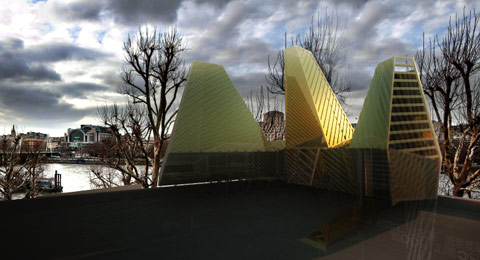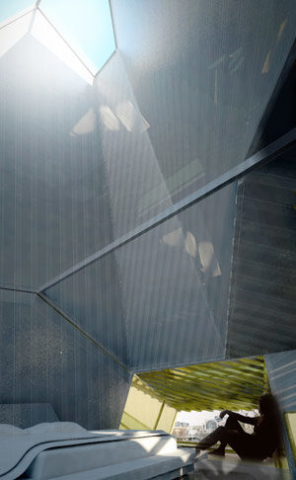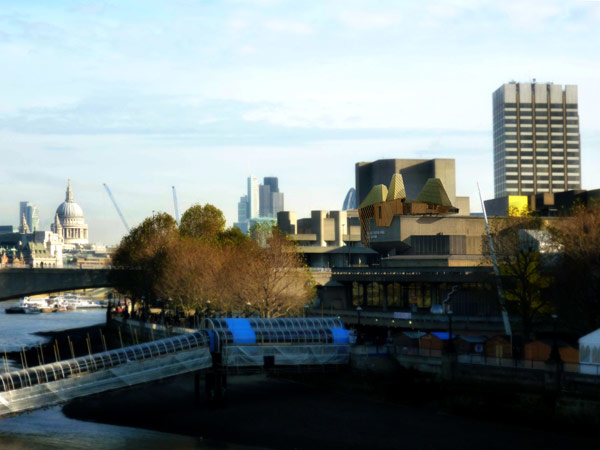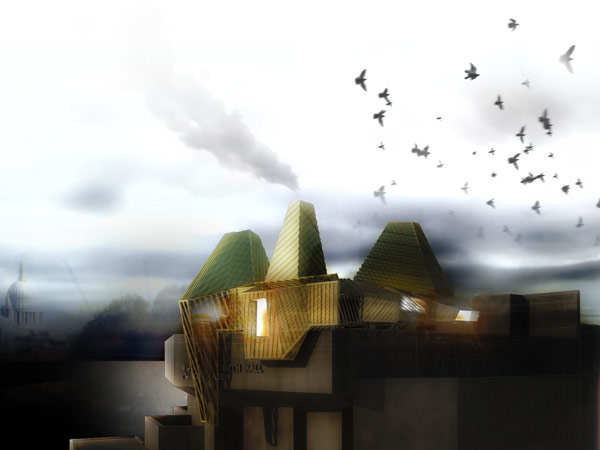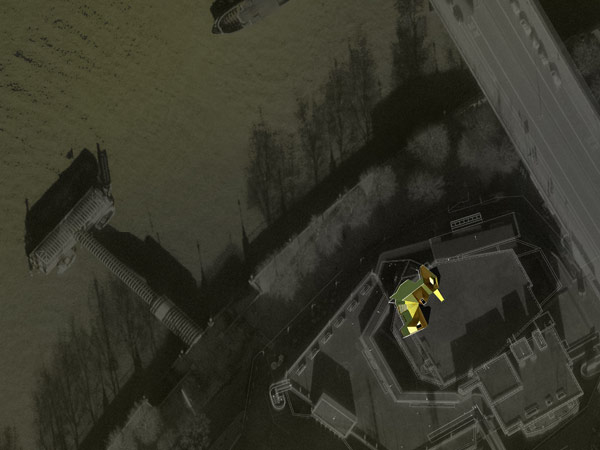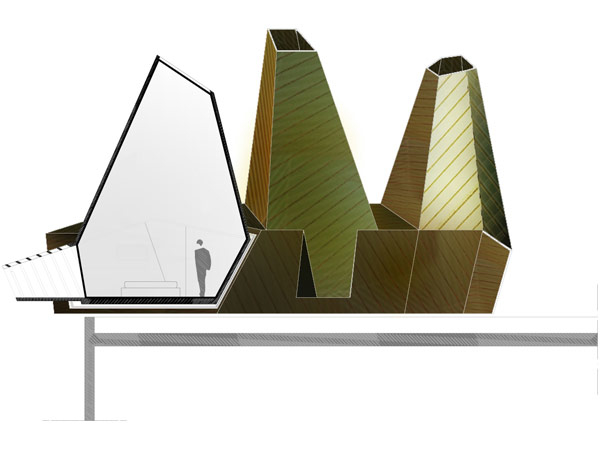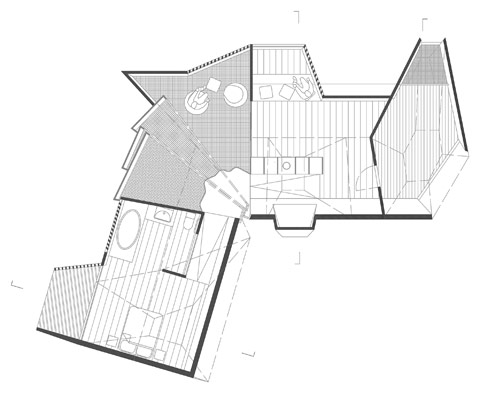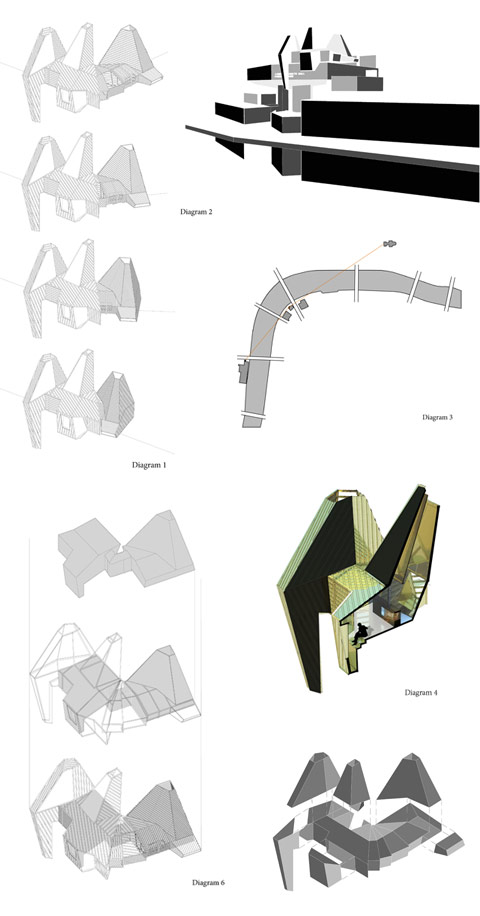Dizajn za konkurs „Soba za London“ – soba sa pogledom na London za vreme trajanja Olimpijade 2012
Tim:
António Miguel Gonçalves, arhitekta sa sedištem u Londonu
Antoine Pascal, arhitekta sa sedištem u Londonu
Anthony Thevenon, arhitekta sa sedištem u Lisabonu
Naša ideja bila je da se na krovu formira telo koje deluje kao živi organizam koje pronalazi različite vizure grada. Na ovaj način artikulisano telo se adaptira na oblik objekta. Želeli smo da postignemo efekat koji izaziva čuđenje kod ljudi u vezi sa oblikom na krovu.
Dijalog sa zgradom
Soba je osmišljena tako da može da menja lokaciju, ali u svojoj memoriji ona uvek zadržava prvu lokaciju. Projekat je osmisljen tako da se igra sa okolnom brutalističkom arhitekturom kao što je Narodno pozorište, zgrada koja je građena u tom duhu u sred Londona bez prigovora. Ovaj princip može objasniti i dizajn sobe koja kao da stoji na tom mestu bez dozvole. Dizajn se ogleda u oštrim uglovima i ponavljanju tih elemenata, koji se mogu jasno identifikovati kao sredstva brutalizma.
Pozicija
Smestili smo objekat na sam rub zgrade zbog severne orjentacije ka Big Benu (sa leve strane, koga skoro da zaklanja zgrada Royal Festival Hall) i Katedrali sv. Pavla (sa desne strane, koja se skoro ne vidi od zgrade Narodnog pozorišta), kao i zbog pozicije koja je istaknuta u vidu novog repera. Izbacivanjem strukture više na sam rub ona postaje uočljivija. Želeli smo da ostvarimo kontakt sa Londonskim repernim tačkama i u isto vreme da formiramo jedan takav orjentir.
Ovakvim izborom izbegli smo konzolna rešenja koja bi bila previše složena i skupa za izvođenje od ovakvih lakih materijala. Soba zahvata severo-zapadni ugao i sa pozicije Waterloo mosta može se videti ulaz u sobu. Kako gost ulazi dublje u sobu, okruženje postaje mirnije. Na ovaj način soba štiti od buke više nego bilo koji skupi izolacioni sistem.
Prednja i zadnja strana
Postoji stalan dialog između objekta, okruženja i grada. Dialog sa okruženjem je postignut upotrebom jezika brutalizma. Sa gradom smo ostvarili dijalog igrajući se sa dihotomijom zadnje i prednje fasade standardnih terasastih kuća koje možemo naći u Londonu. Na ovim kućama sa prednje strane venac sakriva kosi krov (zadnje fasade), tako da dva arhitektonska sistema ignorišu jedan drugi. Ovo je izraženo u poprečnom preseku.
Projekat se poigrava sa ovim izrazom i presek nadvladava i definiše njegov identitet, i zadnja terasa je specifičan odgovor na to (pristupno dvorište i dimnjak u sobi).
Orijentacija
Projekat prihvata jednu orjentaciju. Prednji deo je okrenut ka severu, sa pogledima na Temzu, soba se preliva preko ivice zgrade, južna strana je zatvorena od pogleda i dimnjak koristi za propuštanje svetlosti.
Održivost
Sa ciljem da napravimo održivi projekat morali smo da razmišljamo o životnom ciklusu objekta.
Ovaj projekat je zaista specifičan zbog privremenog karaktera i objekat se može preseliti na drugu lokaciju, tako da su prilagodljivost i jednostavna montaža usvojeni kao dva osnovna uslova.
Tokom procesa projektovanja razmišljali smo o jednostavnim načinima sklapanja i rasklapanja.
Objekat se sastoji od dva dela koji prate isti presek povezana vezom koja omogućava lako prilagođavanje drugačijim situacijama, tako da se svaki put koristi isti skelet. Tela su napravljena od jednostavne čelične strukture na koju se kače različiti dimnjaci koji idu gore ili dole. Oni koji se postavljaju gore zahvataju sunce i uvlače ga unutra tako da obezbeđuju osvetljenje i toplotu, a oni koji idu dole fokusiraju različite vizure koje se mogu ostvariti sa vrha zgrade Queen Elizabeth Hall, ali samo dva od njih deo su unutrašnjosti prostora i njih je bilo potrebno izolovati.
Ova jednostavna struktura i ova dva povezana tela dala su unutrašnju konfiguraciju. Postavili smo čitav zadati program u dva statična tela (spavaća soba, toaleti i dnevni boravak) kako bi omogućili fleksibilnost ostalog prostora.
Što se tiče materijala, želeli smo da koristimo prefabrikovane i standardizovane materijale koji se mogu lako sklopiti i reciklirati. Na ovaj način hteli smo da izbegnemo, koliko je moguće, otpad i druge zagađivače koji inače nastaju na gradilištima.
Design for „A Room for London“ competition – room overlooking London for the duration of the Olympic Year, 2012
Team:
António Miguel Gonçalves, Architect based in London
Antoine Pascal, Architect based in London
Anthony Thevenon, Architect based in Lisbon
Our idea was to create a body in the roof, acting like a living organism finding different views of the city. In this way its articulated body adapts to the building’s shape. We would like to make people wondering what is that shape on the roof.
Dialog with the building
The room is expected to change location, but it will always keep the memories of its first address. The project was designed to play with the surrounding brutalist architecture, as the National Theatre, a building that is a clever way of building a nuclear power station in the middle of London without anyone objecting. This premise can be applied to the room, seems to be there without any permission. The design is based on sharp angles and its repetition, which could be clearly identified as the brutal architecture tools.
Position
We located the project on the edge of the building, because we need to be as much as possible on north, to see Big Ben (on the left, almost hidden by the Royal Festival Hall), and Saint Paul’s Cathedral (on the right side almost hidden by the National Theatre) and to be seen by the people as a new landmark, so the closer we install the structure to the out line of the roof more people will see it. We want to find more points of view related to the London’s landmarks at the same time to create a new spot in the city’s landmark.
This position also avoids a cantilever solution that would be too complex and expensive to construct in this kind of light material. The room is grabbing the North West corner, and from the Waterloo Bridge we will see the room entrance. The deeper the guest is going in the quieter the area around is. In this way the room is protected from noise pollution, more than any wide expensive insulation system.
Back and Front
There is a permanent dialog between the building, the surroundings and the city. The dialog with the surroundings is achieved by using the same brutalist language. With the city we achieved this dialog playing with the dichotomy of back and front facades of the standard terraced houses that we can find in London. In these houses the front with its cornice hides the pitched roofs (back facade), two architectures systems which ignore each other. This is expressed in the transversal section.
The project is playing with this representation, the section prevails to define its identity, and the end terrace is a specific response (entrance patio and chimney in the room).
Orientation
The project is assuming an orientation. The north is the front, with the views on the Thames, the room is dripping over the building, the south is closed from view and we use chimneys to get light in.
Sustainability
In order to do a sustainable project we need to think in the life cycle of the building.
This project is really specific because it is temporary and can be moved for different locations, so adaptation and easy assembly are two essential things.
During the design process we thought in easy ways of assemble and disassemble.
The building it’s composed by two bodies that follow the same section connected buy an articulation that allow an easy adaption to different situations, so we use all the time the same skeleton. The bodies are made of a simple steal structure where we attach the different chimneys that go up and down. The ones that go up capture the sun and make it slide in side providing light and heat, the ones that go down focus on the different views that you can have from the top of Queen Elizabeth Hall but just two of them make part of the inside space and needed to be insulated.
This simple structure and this two articulated bodies gave us the inside configuration. We placed the entire fixed program in the two static bodies (bed room, toilets and living room) to allowed the rest of the space to be flexible for the two patios.
In terms of construction materials we want to use pre-fabricated and standardized materials which can be easily assembled and recycled. With this kind of materials we want to avoid waste as much as we can and other pollutants that normally we produced in the construction site.


